ECO mode MITSUBISHI ASX 2015 Owner's Manual (in English)
[x] Cancel search | Manufacturer: MITSUBISHI, Model Year: 2015, Model line: ASX, Model: MITSUBISHI ASX 2015Pages: 452, PDF Size: 20.1 MB
Page 365 of 452

lUse engine oil conforming to the follow-
ing classification: • ACEA classification: “For service C1, C2, C3 or C4”
• JASO classification: “For service DL-1”
If those classifications are not available,
contact a MITSUBISHI MOTORS Au-
thorized Service Point.NOTEl Use of additives is not recommended since
they may reduce the effectiveness of addi-
tives already included in the engine oil. It may result in failure of the mechanical as-
sembly.Engine coolant
E01000503437
To check the coolant level
A transparent coolant reserve tank (A) is lo-cated in the engine compartment.
The coolant level in this tank should be kept
between the “LOW” and “FULL” marks when measured while the engine is cold.To add coolant
The cooling system is a closed system andnormally the loss of coolant should be very
slight. A noticeable drop in the coolant level
could indicate leakage. If this occurs, we rec- ommend you to have the system checked as
soon as possible.
If the level should drop below the “LOW” level on the reserve tank, open the lid and
add coolant.
Also, if the reserve tank is completely empty, remove the radiator cap (B) and add coolant until the level reaches the filler neck.
WARNINGl Do not open the radiator cap (B) while the
engine is hot. The coolant system is under
pressure and any hot coolant escaping
could cause severe burns.
Anti-freeze
The engine coolant contains an ethylene gly-
col anti-corrosion agent. Some parts of the engine are cast aluminium alloy, and periodic
changing of the engine coolant is necessary to prevent corrosion of these parts.
Engine coolant
10-07OGAE15E5Maintenance10 Except for diesel-powered vehicles 1600 models
FULLLOW Diesel-powered vehicles 1600 modelsFULLLOW
Page 366 of 452
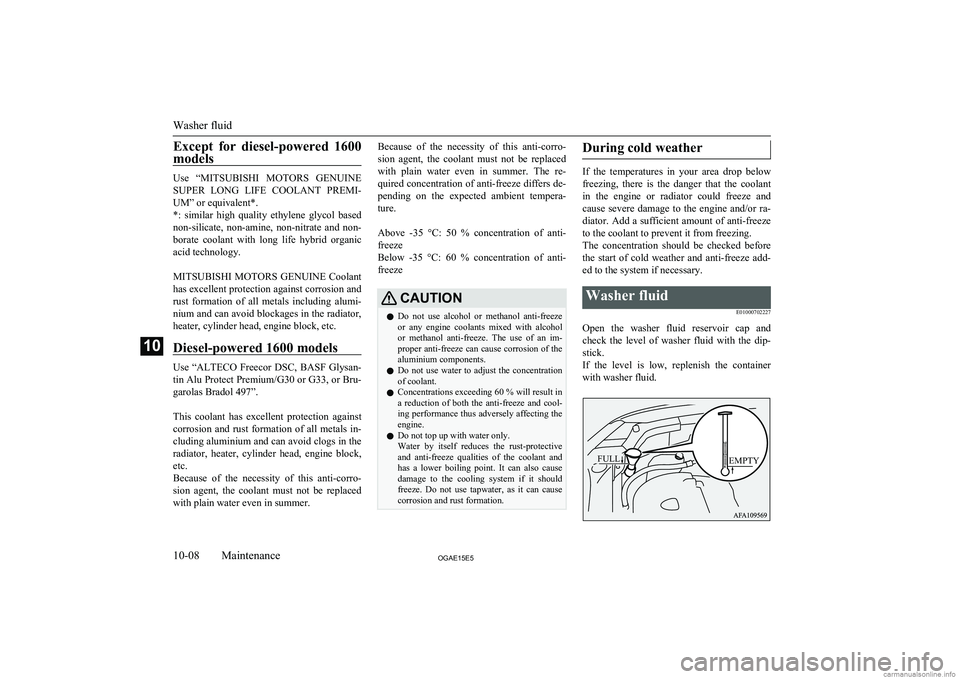
Except for diesel-powered 1600models
Use “ MITSUBISHI MOTORS GENUINE
SUPER LONG LIFE COOLANT PREMI-
UM” or equivalent*.
*: similar high quality ethylene glycol based
non-silicate, non-amine, non-nitrate and non- borate coolant with long life hybrid organic acid technology.
MITSUBISHI MOTORS GENUINE Coolant
has excellent protection against corrosion and rust formation of all metals including alumi-
nium and can avoid blockages in the radiator,
heater, cylinder head, engine block, etc.
Diesel-powered 1600 models
Use “ALTECO Freecor DSC, BASF Glysan- tin Alu Protect Premium/G30 or G33, or Bru-
garolas Bradol 497”.
This coolant has excellent protection against
corrosion and rust formation of all metals in-
cluding aluminium and can avoid clogs in the
radiator, heater, cylinder head, engine block,
etc.
Because of the necessity of this anti-corro-
sion agent, the coolant must not be replaced with plain water even in summer.
Because of the necessity of this anti-corro-
sion agent, the coolant must not be replaced with plain water even in summer. The re-
quired concentration of anti-freeze differs de-
pending on the expected ambient tempera- ture.
Above -35 °C: 50 % concentration of anti-
freeze
Below -35 °C: 60 % concentration of anti-
freezeCAUTIONl Do not use alcohol or methanol anti-freeze
or any engine coolants mixed with alcohol or methanol anti-freeze. The use of an im-
proper anti-freeze can cause corrosion of the aluminium components.
l Do not use water to adjust the concentration
of coolant.
l Concentrations exceeding 60 % will result in
a reduction of both the anti-freeze and cool-
ing performance thus adversely affecting the engine.
l Do not top up with water only.
Water by itself reduces the rust-protective
and anti-freeze qualities of the coolant and has a lower boiling point. It can also causedamage to the cooling system if it should freeze. Do not use tapwater, as it can causecorrosion and rust formation.During cold weather
If the temperatures in your area drop below
freezing, there is the danger that the coolant
in the engine or radiator could freeze and cause severe damage to the engine and/or ra-diator. Add a sufficient amount of anti-freeze
to the coolant to prevent it from freezing. The concentration should be checked before the start of cold weather and anti-freeze add- ed to the system if necessary.
Washer fluid
E01000702227
Open the washer fluid reservoir cap andcheck the level of washer fluid with the dip- stick.
If the level is low, replenish the container with washer fluid.
Washer fluid
10-08OGAE15E5Maintenance10 FULLEMPTY
Page 368 of 452

NOTElAfter replacing the battery, the electronic
control system data for the automatic trans- mission, etc., will be erased. As a result,
shift shocks may occur.
Shift shocks will become smoother after sev-
eral changes in speed.
Checking battery electrolyte
level (Type 1 only)
The electrolyte level must be between the specified limit on the outside of the battery.
Replenish with distilled water as necessary.
The inside of the battery is divided into sev- eral compartments; remove the cap from each
compartment and fill to the upper mark. Do not top up beyond the upper mark because
spillage during driving could cause damage.
Check the electrolyte level at least once every
4 weeks, depending on the operating condi- tions.
If the battery is not used, it will discharge by
itself with time.
Check it once every 4 weeks and charge with
low current as necessary.
NOTEl Except for diesel-powered 1600 models, to
replenish with the distilled water, remove
the upper cover and duct.
Refer to “Removing and installing the upper cover and duct” on page 10-10.Removing and installing the
upper cover and duct
E01010700112
WARNINGl Turn the ignition switch to the “LOCK”
position or put the operation mode in OFF.
Make sure that your clothes cannot be
caught by the fan or drive belt. Personal
injury could result.
Battery
10-10OGAE15E5Maintenance10 Except for diesel-powered vehicles 1600 models Diesel-powered 1600 models
Page 370 of 452
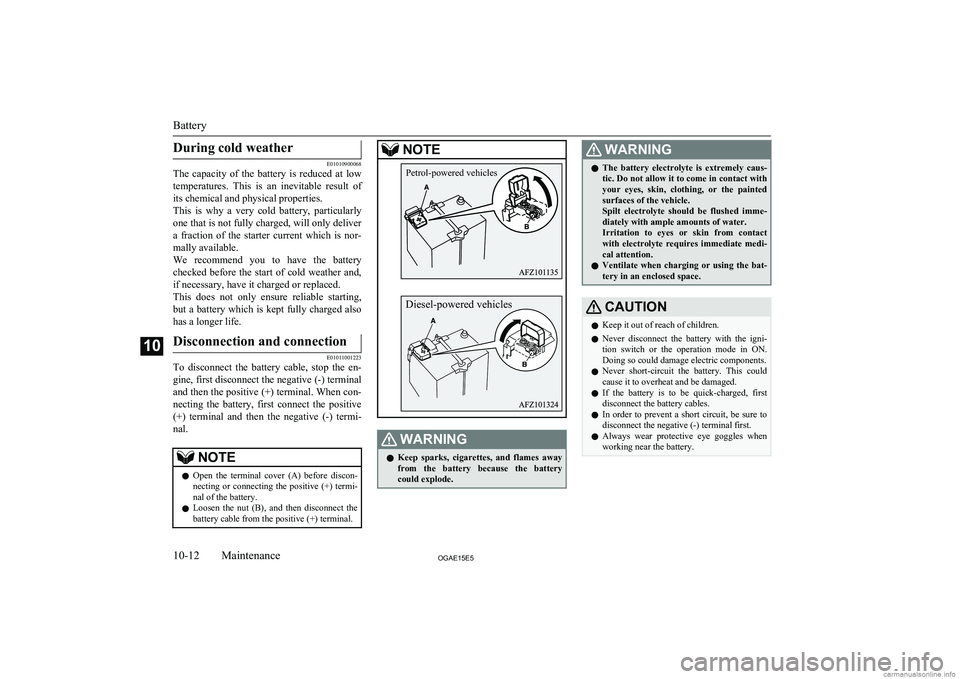
During cold weather
E01010900068
The capacity of the battery is reduced at low
temperatures. This is an inevitable result of
its chemical and physical properties. This is why a very cold battery, particularly one that is not fully charged, will only deliver a fraction of the starter current which is nor-
mally available.
We recommend you to have the battery checked before the start of cold weather and,
if necessary, have it charged or replaced.
This does not only ensure reliable starting, but a battery which is kept fully charged alsohas a longer life.
Disconnection and connection
E01011001223
To disconnect the battery cable, stop the en- gine, first disconnect the negative (-) terminal
and then the positive (+) terminal. When con-
necting the battery, first connect the positive
(+) terminal and then the negative (-) termi- nal.
NOTEl Open the terminal cover (A) before discon-
necting or connecting the positive (+) termi-
nal of the battery.
l Loosen the nut (B), and then disconnect the
battery cable from the positive (+) terminal.NOTEWARNINGl Keep sparks, cigarettes, and flames away
from the battery because the battery could explode.WARNINGl The battery electrolyte is extremely caus-
tic. Do not allow it to come in contact with
your eyes, skin, clothing, or the painted surfaces of the vehicle.
Spilt electrolyte should be flushed imme-
diately with ample amounts of water.
Irritation to eyes or skin from contact with electrolyte requires immediate medi-
cal attention.
l Ventilate when charging or using the bat-
tery in an enclosed space.CAUTIONl Keep it out of reach of children.
l Never disconnect the battery with the igni-
tion switch or the operation mode in ON.
Doing so could damage electric components.
l Never short-circuit the battery. This could
cause it to overheat and be damaged.
l If the battery is to be quick-charged, first
disconnect the battery cables.
l In order to prevent a short circuit, be sure to
disconnect the negative (-) terminal first.
l Always wear protective eye goggles when
working near the battery.
Battery
10-12OGAE15E5Maintenance10 Petrol-powered vehicles Diesel-powered vehicles
Page 383 of 452
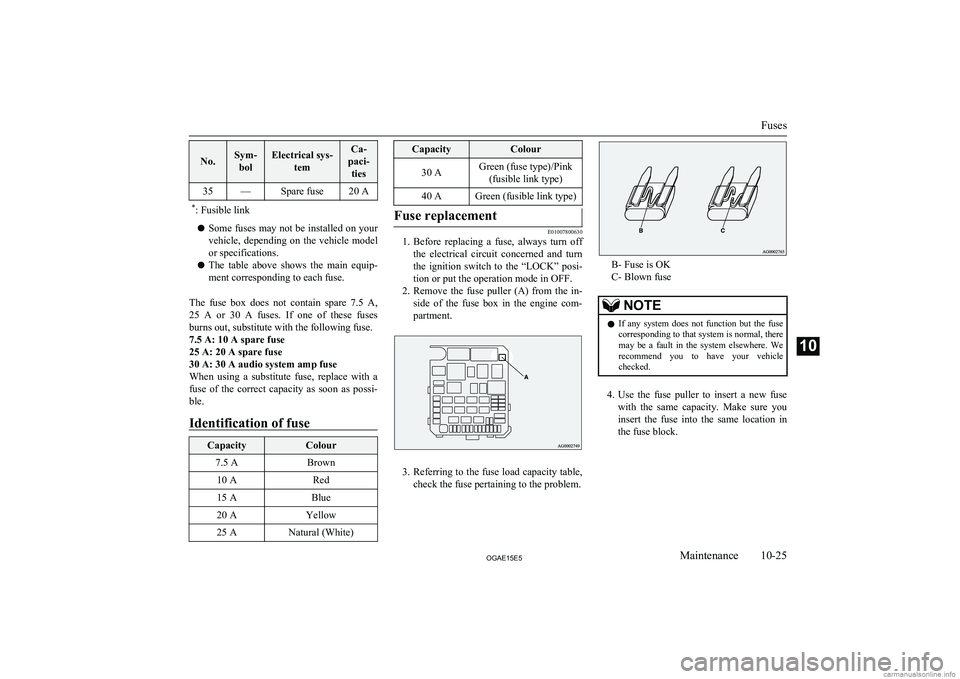
No.Sym-bolElectrical sys- temCa-
paci- ties35—Spare fuse20 A* : Fusible link
l Some fuses may not be installed on your
vehicle, depending on the vehicle model
or specifications.
l The table above shows the main equip-
ment corresponding to each fuse.
The fuse box does not contain spare 7.5 A ,
25 A or 30 A fuses. If one of these fuses burns out, substitute with the following fuse.7.5 A: 10 A spare fuse
25 A: 20 A spare fuse
30 A: 30 A audio system amp fuse
When using a substitute fuse, replace with a
fuse of the correct capacity as soon as possi- ble.
Identification of fuse
CapacityColour7.5 ABrown10 ARed15 ABlue20 AYellow25 ANatural (White)CapacityColour30 AGreen (fuse type)/Pink (fusible link type)40 AGreen (fusible link type)Fuse replacement
E01007800630
1. Before replacing a fuse, always turn off
the electrical circuit concerned and turn
the ignition switch to the “LOCK” posi-
tion or put the operation mode in OFF.
2. Remove the fuse puller (A) from the in-
side of the fuse box in the engine com-
partment.
3. Referring to the fuse load capacity table,
check the fuse pertaining to the problem.
B- Fuse is OK
C- Blown fuse
NOTEl If any system does not function but the fuse
corresponding to that system is normal, theremay be a fault in the system elsewhere. We recommend you to have your vehiclechecked.
4. Use the fuse puller to insert a new fuse
with the same capacity. Make sure you
insert the fuse into the same location in
the fuse block.
Fuses
10-25OGAE15E5Maintenance10
Page 405 of 452

NOTElTrailer specifications indicate the manufacturer’s recommendation.
Item
2000 models2WD4WDM/TCVTINTENSEINVITEINTENSEKerb weightWithout optional parts1,360 kg1,450 kg1,455 kgWith full optional parts1,413 kg1,463 kg1,517 kgMaximum gross vehicle weight1,970 kg, 2,035 kg *Maximum axle weight
Front1,030 kgRear1,000 kg, 1,085 kg*Maximum towable weightWith brake1,300 kgWithout brake715 kg745 kgMaximum trailer-nose weight65 kgMaximum roof load80 kgSeating capacity5 persons*
: In case of trailer towingNOTEl Trailer specifications indicate the manufacturer’s recommendation.
Vehicle weight
11-09OGAE15E5Specifications11
Page 406 of 452
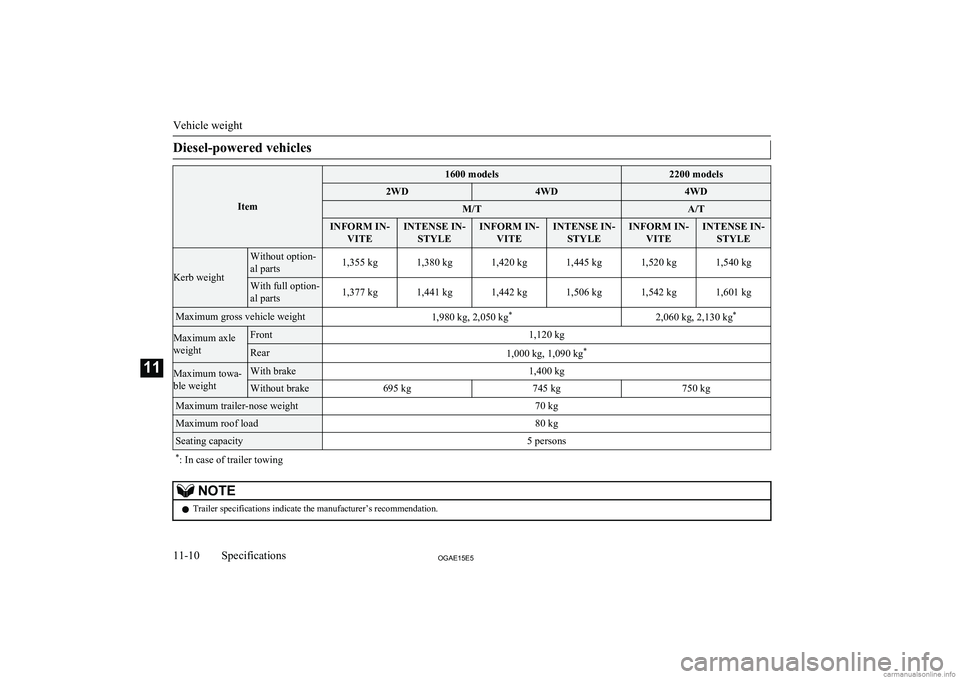
Diesel-powered vehicles
Item
1600 models2200 models2WD4WD4WDM/TA/TINFORM IN-VITEINTENSE IN-STYLEINFORM IN- VITEINTENSE IN-STYLEINFORM IN- VITEINTENSE IN-STYLE
Kerb weight
Without option-
al parts1,355 kg1,380 kg1,420 kg1,445 kg1,520 kg1,540 kgWith full option-
al parts1,377 kg1,441 kg1,442 kg1,506 kg1,542 kg1,601 kgMaximum gross vehicle weight1,980 kg, 2,050 kg *2,060 kg, 2,130 kg*Maximum axle
weightFront1,120 kgRear1,000 kg, 1,090 kg *Maximum towa-
ble weightWith brake1,400 kgWithout brake695 kg745 kg750 kgMaximum trailer-nose weight70 kgMaximum roof load80 kgSeating capacity5 persons* : In case of trailer towingNOTEl Trailer specifications indicate the manufacturer’s recommendation.
Vehicle weight
11-10OGAE15E5Specifications11
Page 415 of 452
![MITSUBISHI ASX 2015 Owners Manual (in English) No.ItemQuantityLubricants
4
Engine coolant (pet-
rol-powered vehi-
cles)1800 models,
2000 models7.5 litres [includes
0.65 litre in the re- serve tank]MITSUBISHI MOTORS GENUINE SUPER
LONG LIFE COOLANT MITSUBISHI ASX 2015 Owners Manual (in English) No.ItemQuantityLubricants
4
Engine coolant (pet-
rol-powered vehi-
cles)1800 models,
2000 models7.5 litres [includes
0.65 litre in the re- serve tank]MITSUBISHI MOTORS GENUINE SUPER
LONG LIFE COOLANT](/img/19/34864/w960_34864-414.png)
No.ItemQuantityLubricants
4
Engine coolant (pet-
rol-powered vehi-
cles)1800 models,
2000 models7.5 litres [includes
0.65 litre in the re- serve tank]MITSUBISHI MOTORS GENUINE SUPER
LONG LIFE COOLANT PREMIUM or equiva-
lent*
Engine coolant (die-
sel-powered vehicles)
1600 models
7.4 litres [includes
0.62 litre in the re- serve tank]ALTECO Freecor DSC, BASF Glysantin Alu
Protect Premium/G30 or G33, or Brugarolas Bra- dol 497
2200 models
7.5 litres [includes
0.65 litre in the re- serve tank]MITSUBISHI MOTORS GENUINE SUPER
LONG LIFE COOLANT PREMIUM or equiva-
lent*5Automatic transmission fluid8.2 litresMITSUBISHI MOTORS GENUINE ATF-J36CVT fluid6.9 litresMITSUBISHI MOTORS GENUINE CVTF-J4*
: similar high quality ethylene glycol based non-silicate, non-amine, non-nitrate and non-borate coolant with long life hybrid organic acid tech-
nologyCAUTIONl For the automatic transmission fluid, use only the
MITSUBISHI MOTORS GENUINE ATF and for the CVT fluid, use only the MITSUBISHI MOTORS
GENUINE CVTF. Use of a different fluid could damage the transmission.No.ItemQuantityLubricants
7Manual transmission oil
5 M/T1600 models2.0 litres
MITSUBISHI MOTORS GENUINE NEW MUL-
TI GEAR OIL
API classification GL-3, SAE 75W-80
2000 models2.5 litres6 M/T1600 mod- els2WD2.6 litres4WD2.7 litres8Transfer oil0.5 litreMITSUBISHI MOTORS GENUINE Super Hy-poid Gear Oil API classification GL-5 SAE 80
Refill capacities
11-19OGAE15E5Specifications11
Page 419 of 452
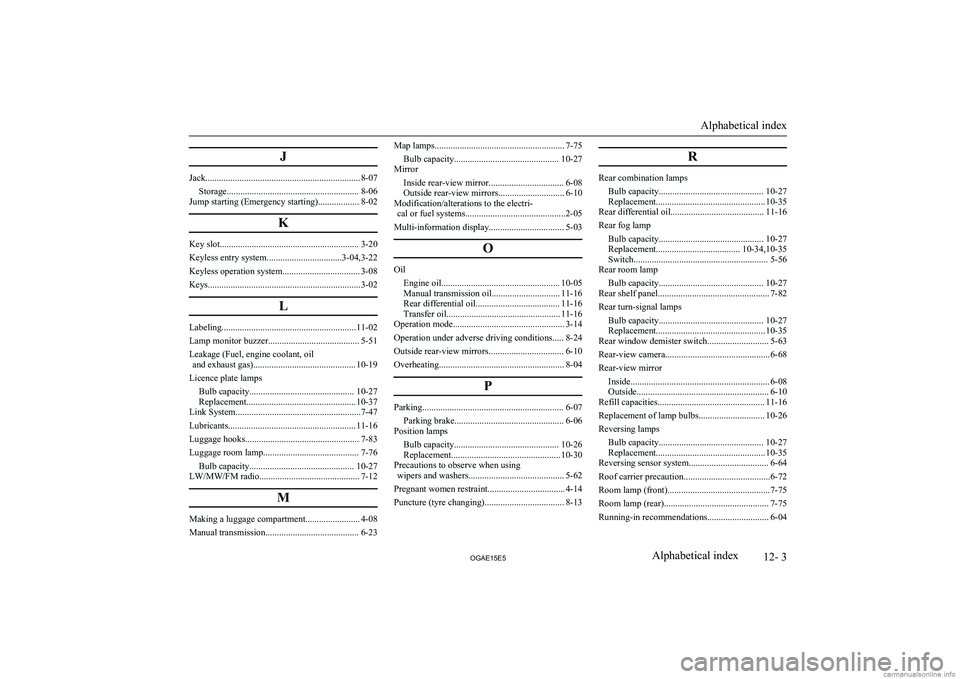
J
Jack.................................................................... 8-07Storage.......................................................... 8-06
Jump starting (Emergency starting).................. 8-02
K
Key slot............................................................. 3-20
Keyless entry system.................................3-04,3-22
Keyless operation system.................................. 3-08
Keys...................................................................3-02
L
Labeling...........................................................11-02
Lamp monitor buzzer........................................ 5-51
Leakage (Fuel, engine coolant, oil and exhaust gas)............................................. 10-19
Licence plate lamps Bulb capacity.............................................. 10-27
Replacement................................................ 10-37
Link System.......................................................7-47
Lubricants........................................................ 11-16
Luggage hooks.................................................. 7-83
Luggage room lamp.......................................... 7-76 Bulb capacity.............................................. 10-27
LW/MW/FM radio............................................ 7-12
M
Making a luggage compartment........................ 4-08
Manual transmission......................................... 6-23
Map lamps......................................................... 7-75 Bulb capacity.............................................. 10-27
Mirror
Inside rear-view mirror................................. 6-08
Outside rear-view mirrors............................. 6-10
Modification/alterations to the electri- cal or fuel systems............................................2-05
Multi-information display................................. 5-03
O
OilEngine oil.................................................... 10-05Manual transmission oil.............................. 11-16Rear differential oil..................................... 11-16
Transfer oil.................................................. 11-16
Operation mode................................................. 3-14
Operation under adverse driving conditions..... 8-24
Outside rear-view mirrors................................. 6-10
Overheating....................................................... 8-04
P
Parking.............................................................. 6-07Parking brake................................................ 6-06
Position lamps
Bulb capacity.............................................. 10-26
Replacement................................................ 10-30
Precautions to observe when using wipers and washers.......................................... 5-62
Pregnant women restraint.................................. 4-14
Puncture (tyre changing)................................... 8-13
R
Rear combination lamps Bulb capacity.............................................. 10-27
Replacement................................................ 10-35
Rear differential oil......................................... 11-16
Rear fog lamp Bulb capacity.............................................. 10-27
Replacement..................................... 10-34,10-35
Switch........................................................... 5-56
Rear room lamp
Bulb capacity.............................................. 10-27
Rear shelf panel................................................. 7-82
Rear turn-signal lamps Bulb capacity.............................................. 10-27
Replacement................................................ 10-35
Rear window demister switch........................... 5-63
Rear-view camera..............................................6-68
Rear-view mirror Inside............................................................. 6-08
Outside.......................................................... 6-10
Refill capacities............................................... 11-16
Replacement of lamp bulbs............................. 10-26
Reversing lamps Bulb capacity.............................................. 10-27
Replacement................................................ 10-35
Reversing sensor system................................... 6-64
Roof carrier precaution......................................6-72
Room lamp (front).............................................7-75
Room lamp (rear).............................................. 7-75
Running-in recommendations........................... 6-04Alphabetical index
12- 3
OGAE15E5Alphabetical index
Page 451 of 452
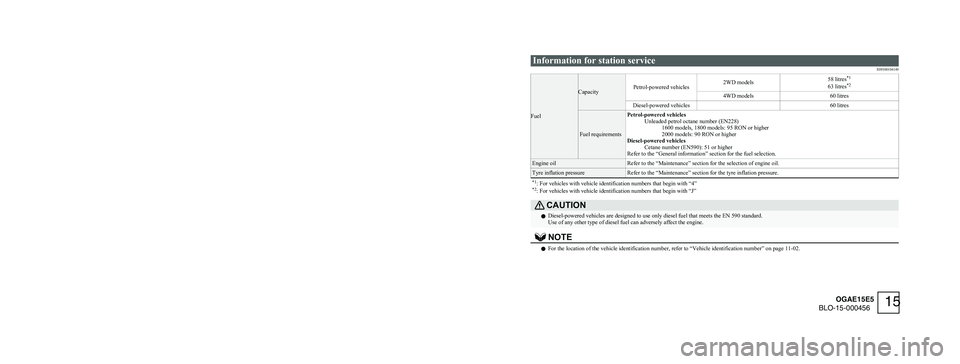
Foreword
E09200106344
Thank you for selecting an ASX as your new vehicle.
This owner’s manual
will add to your understanding and full enjoyment of
the many fine features of this vehicle.
It contains information prepared to acquaint you with the proper way to oper-
ate and maintain your vehicle for the utmost in driving pleasure.
MITSUBISHI MOTORS Europe B.V. reserves the right to make changes in
design and specifications and/or to make additions to or improvements in
this product without obligation to install them on products previously manu- factured.
It is an absolute requirement for the driver to strictly observe all laws and
regulations concerning vehicles.
This owner’s manual has been written in compliance with such laws and reg-
ulations, but some of the contents may become contradictory with later amendment of the laws and regulations.
Please leave this owner’s manual in this vehicle at time of resale. The next
owner will appreciate having access to the information contained in this
owner’s manual.
Repairs to your vehicle:
Vehicles in the warranty period:
All warranty repairs must be carried out by a MITSUBISHI MOTORS Au- thorized Service Point.
Vehicles outside the warranty period:
Where the vehicle is repaired is at the discretion of the owner. Throughout this owner’s manual the words
WARNING and CAUTION
appear.
These serve
as reminders to be especially careful. Failure to follow instruc-
tions could result in personal injury or damage to your vehicle. WARNING
indicates a strong possibility of severe personal injury or death if in- structions are not followed. CAUTION
means hazards or unsafe practices that could cause minor personal in-
jury or damage to your vehicle.
You will see another important symbol: NOTE: gives helpful information.
*: indicates optional equipment.It may differ
according to the sales classification; refer
to the sales catalogue.
Abbreviations used in this owner’s manual:
LHD: Left-Hand Drive
RHD: Right-Hand Drive
M/T: Manual Transmission
A/T: Automatic Transmission
CVT: Continuously Variable Transmission
The symbol used on the vehicles: : See owner’s manual Information for station service
E09300104149 Fuel Capacity
Petrol-powered vehicles 2WD models
58 litres
*1
63 litres *2
4WD models 60 litres
Diesel-powered vehicles 60 litres Fuel requirements
Petrol-powered vehicles
Unleaded petrol octane number (EN228)1600 models, 1800 models: 95 RON or higher
2000 models: 90 RON or higher
Diesel-powered vehicles Cetane number (EN590): 51 or higher
Refer to the “General information” section for the fuel selection. Engine oil
Refer to the “Maintenance” section for the selection of engine oil. Tyre inflation pressure
Refer to the “Maintenance” section for the tyre inflation pressure.
*1 : For vehicles with vehicle identification numbers that begin with “4”
*2 : For vehicles with vehicle identification numbers that begin with “J” CAUTION
l Diesel-powered vehicles are designed to use only diesel fuel that meets the EN 590 standard.
Use of any other type of diesel fuel can adversely affect the engine. NOTE
l
For the location of the vehicle identification number, refer to “Vehicle identification number” on page 11-02. © 2015 Mitsubishi Motors Corporation
15 OGAE15E5
BLO-15-000456